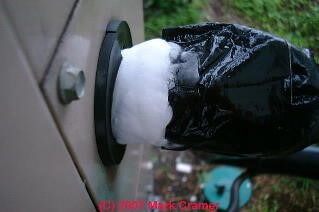A frozen inside coil often indicates a problem with either blocked airflow or low refrigerant. A basic check of your refrigerant level will confirm or deny a charge problem. A low charge condition will cause icing on the inside coil or even the side of the compressor and needs a qualified service tech to correct.
Other causes of icing are strictly related to air flow through the inside unit. Dirty air filters, missing air filters, dirty evaporator coils, or blocked return air grills or ductwork are common causes.  Make certain filters are clean and there is no furniture or other objects restricting air flow. (NEVER run a unit without a proper filter!)
Make certain filters are clean and there is no furniture or other objects restricting air flow. (NEVER run a unit without a proper filter!)
Under some conditions a unit may freeze if the thermostat is set to a very low temperature (under 65 degrees) in a humid environment. While this may happen during a change of seasons or sometimes at night, it is not a good thing. A unit that freezes should be checked by a qualified technician.
A unit can be defrosted by simply turning it off for a few hours. A faster defrost can be done by turning the fan from “AUTO” to “ON” and while the heating/cooling switch is set to “OFF”. With the fan only settings on, the warmer air will be pushed against the ice causing it to melt faster than if simply left off.
In many cases, a homeowner can prevent these common problems through effective preventive maintenance. Make sure airways are clear and filters are clean at all times. However, if freezing is common or chronic, a qualified NATE-certified technician can quickly check a system for problems and make necessary repairs before the unit is damaged or a more serious breakdown occurs.